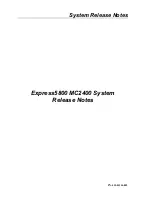
NTS-6001 WEB CONFIGURATION
www.
galsys
.co.uk
galleonsupport
.com
TEL:
+44 (0) 121 608 4433
FAX:
+44 (0) 121 608 4477
NTP KEYS
The NTP standard specifies an extension allowing verification of the authenticity of received NTP
Packets, and to provide an indication of authenticity in outgoing packets. The specification allows
any one of possibly 4 billion keys, numbered with 32 bit key identifiers, to be used to authenticate
an association.
The servers involved in an association must agree on the key and key identifier used to authenticate
their data, although they must each learn the key and key identifier independently.
You cannot change key number ‘0’ because the NTP standard fixes it as 64 zero bits.
Key entries use the following format:
{KeyNumber} {KeyType} {Key}
Where,
Entry
Description
{KeyNumber}
A positive integer between 1 – 65,534
{KeyType}
Specifies the Key Type:
An A key is just a sequence of up to eight ASCII characters (some
characters with special meaning can't be used).
An M key is a sequence of up to 31 ASCII characters.
An S key is a 64 bit value with the low order bit of each byte being
odd parity.
An A key is a 64 bit value with the high order bit of each byte being
odd parity.
{Key}
The Key itself based on the type as above.
Examples:
1 A Hdb;lQw]
2 M |Q)DFP!S]<`L[R.eM]20
3 M P)o-[B)@askS+?[>&U.0
4 M "sAk:`)UJ|={mVtT|cB<
The Key numbers may be used with commands on the NTP customisation page. If you use the ntp-
keygen command in Linux then you will need to remove the ‘D5’ from ‘MD5’.






































